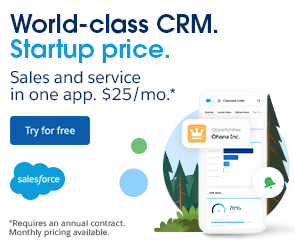Learn the differences between leads, prospects, and opportunities. Understand how to turn leads into prospects and opportunities.
Selling Signals content and product recommendations are editorially independent. We may make money when you click on links to our partners. Learn More.
Door-to-door sales can be a major lead generator for your company and a great way to make money as a salesperson. Getting started selling at cold leads' homes or businesses can be nerve-racking, so we want to make sure you feel as prepared as possible. To help, we talked with experienced sellers to compile the best tips to develop your skills as a door-to-door sales pro.
Before you start traveling to your leads' homes or offices and knocking on doors, be sure you're prepared enough to perform well when they answer. Take a look at these tips from door-to-door sales experts regarding how to get ready to sell:

Jason McMahon
Digital Strategist, Bambrick
First and foremost, it's vital to understand your product well enough to explain it in your pitch and to answer any questions that your lead asks. Digital strategist Jason McMahon told us why all door-to-door salespeople need to know their product or service inside and out:
"Once you've gotten your foot in the door with a potential buyer, the conversation can go in any direction. Prepare responses to as many questions as possible in order to lead the discussion towards your sales objectives. Spend a few hours reviewing your product literature or your company's website so that you can confidently answer practically every imaginable inquiry."
— Jason McMahon, Digital Strategist, Bambrick
To get some practice before heading out into the real world, have a coworker pose as a lead and ask you to elaborate on or clarify certain aspects of your product.

Stephen Bumb
VP Marketing, American Medical Technologies
Hammering out a general ideal customer profile is important, and all sales professionals can also benefit from digging a little deeper. We spoke with Stephen Bumb, VP of Marketing at American Medical Technologies, and he had this to say:
"Do your homework. Understand the priorities of your lead. Use all resources to gather info on strategies, objectives, and challenges. Understand how your solution aligns with one or more of the top three priorities of your potential customer persona. If it doesn’t, rethink your value proposition."
— Stephen Bumb, VP of Marketing, American Medical Technologies
Your leads usually have a few key priorities — for example, they might want to spend less money, increase productivity, solve a problem at home or in the workplace, and/or have peace of mind. Research your leads, find their priorities, then link them to your product or service.

Tyler Martin
Founder, ThinkTyler
First impressions can make or break a conversation with a lead. Founder and coach Tyler Martin explained why it's important to find the right balance in your attire so it matches your industry and what you're selling:
"Do not put on a suit and tie just because your boss instructs you to. Casual jeans and a shirt will suffice. However, whatever you wear should be professional enough to counteract any negative feelings the prospects may have about a stranger knocking on their door. Of course, you must dress appropriately for the weather and choose comfortable shoes that will allow you to walk for miles."
— Tyler Martin, Founder & Certified Business Coach, ThinkTyler
By choosing an outfit that's appropriate for your lead, the weather, and your comfort, you should find more success in your conversations and more endurance throughout your day.

Gerrid Smith
Chief Marketing Officer, Joy Organics
Speaking of weather, also think about how the weather, and when exactly you knock on doors, can affect your lead. Chief marketing officer Gerrid Smith expanded on this idea:
"The weather, the time of day, and the day of the week are just a few examples of how the environment can help your sale. Choosing a warm-weather day, rather than a hot or rainy day, may encourage someone to walk outside on the front doorstep to hear more of your pitch."
— Gerrid Smith, Chief Marketing Officer, Joy Organics
Getting your lead to answer the door and listen to you can be tough, so make it easier on the lead by considering their schedule and comfort.

Sarah Jameson
Marketing Director, Green Building Elements
Rather than showing up in an area and knocking on every door you see, prioritize the most appropriate areas and the most promising leads in those areas. Sarah Jameson described how to do this so you can increase your conversion rate:
"Salespeople used to haul their vacuum from one neighbor to the next, ring doorbells, and ask for a demonstration of how well their vacuum worked. If one sale didn't work out, they moved on to the next. But, happily, thanks to technological advancements, you no longer have to throw spaghetti at the wall to see what sticks. Instead, prospect intelligently and only go to doors where you have a good possibility of making a sale."
— Sarah Jameson, Marketing Director, Green Building Elements
When weighing where to knock on doors and which ones to visit, be choosy about the leads you speak with. You’ll find that it takes much less time to meet your monthly goals and you feel less burnt out at the end of each day.
Not every lead will answer the door, so it's important to make the most of the conversations you have with the ones that do. The pros below have shared their advice for making the best impression possible and getting the outcome you want:

Mitchell Stern
Owner, SideHustle.Tips
When you start visiting your leads, adjust the way you're standing before each lead answers the door. Business owner Mitchell Stern told us how standing at a certain angle can help lower your lead's defenses right away:
"Some body postures are more aggressive than others. When we're looking to confront someone, we face them directly. When we want to ignore them, we turn to the side at a perfect 90-degree angle. The ideal body angle for a sales situation is right in the middle: about 30-45 degrees. This 'off-angle' says 'I'm not a threat' while still conveying attentiveness. This posture helps the lead relax, which puts them in a more malleable state of mind."
— Mitchell Stern, Owner, SideHustle.Tips
Practice standing this way throughout your conversations to develop your muscle memory. You'll naturally move throughout the conversation to hand the lead materials, collect the lead's information, or give a demo, so get in the habit of returning to this angle.

Andy LaPointe
Sales Manager & Trainer
It's natural to want to ask if you're bothering your lead when they open the door. Sales manager and trainer Andy LaPointe explained to how to flip this negative thought into a positive, more confident one:
"Introduce yourself and don't say 'Did I catch you at a bad time?' The immediate answer to that question is 'yes.' Say this instead: 'Did I catch you at a half-way decent time?' Most of the time, you'll get a laugh, and then you'll be able to start your pitch."
— Andy LaPointe, National Sales Manager & Sales Trainer
Andy's phrase still acknowledges that it might not be the best time for the lead, but it helps encourage them to give you a moment of their time.

Sabrina Victoria
Creator & CEO, Human Better 365
Having the awareness that your lead might not want to speak with you can empower you to verbally recognize this right away and explain why the lead should listen to you anyway. Creator and CEO Sabrina Victoria told us how she does this:
"Know the common objections and answer as many of them as possible in your opening statement. The two most common objections are usually time and money, so make it your goal to alleviate those two objections right off the bat. Doing this will have the customer standing there dumbfounded trying to flip through their list of excuses. So while they are trying to think, you can move on to the next step in the sale or the next question. Something like, 'This will take only two minutes of your time and costs you absolutely nothing.' "
— Sabrina Victoria, Creator & CEO, Human Better 365
Addressing these common objections can help ease your lead's concerns and make them feel more willing to hear you out. For more about sales objections, read our article on objection handling, where you'll learn the main types you'll hear plus strategies to overcome them.

Tanner Arnold
President & CEO, Revelation Machinery
Portraying confidence from the get-go will communicate to your lead that you trust your product or service, your business, and yourself to help them, which will inspire the same confidence in the lead. President and CEO Tanner Arnold described what happens when you're confident:
"Confidence is an important sales tool. You'll pitch differently if you know that you're aware of what you're offering. You'll be able to adjust to this prospect's individual demands, you won't be scared to explore the parts of your offering that are most relevant to the prospect, and you'll be able to negotiate fluidly before the prospect even realizes you're negotiating."
— Tanner Arnold, President & CEO, Revelation Machinery
When you start speaking with a lead, tell yourself that you've sufficiently prepared for this moment, and show that confidence to the lead.

Lauren Cook-McKay
Director of Marketing, Divorce Answers
As you try to sell to your leads, remember that you're two humans, not just a seller and a lead. Marketing and content director Lauren Cook-McKay gave us advice on how to establish a person-to-person connection with your leads:
"While a salesman's purpose is to sell and offload products to new clients, interacting with individuals during each sales interaction is critical for the sale and the company's reputation. Simply remembering a buyer's name and inquiring how their day went might create the tone for a more successful and trustworthy encounter. People appreciate talking about the things and people they care about, so establish a personal connection to aid in the sale. People will want to collaborate with you if you build a trusting relationship with them."
— Lauren Cook-McKay, Director of Marketing & Content, Divorce Answers
People buy from people, so make your leads like you, and you'll find more success in your door-to-door sales efforts.

Chris Kille
President & CEO, Capital Bankcard South
After you finish your initial pleasantries and connect with the lead, jump right in to why you're on their doorstep or at their business. Even the friendliest leads will likely want you to get to the reason you're there, as Chris Kille detailed:
"Be polite, but get to the point. Be clear and concise — remember, you stopped in without an appointment. After pleasantries, it's time for who you are, why you are there, and how you can bring value to this person's life. Getting to this quickly helps to qualify the prospect so you're not wasting your time or theirs."
— Chris Kille, President & CEO, Capital Bankcard South
People are busy, so respect their time by staying for only a few minutes. You can book a longer call or meeting with them at a time that works well, but your initial conversation should be brief and to the point.

Khabeer Rockley
Director, The 5% Institute
Selling a product is often a process of finding a need and filling it. Use your lead's “pain points” — problems that they're experiencing — to explain how your product could help solve them. Director Khabeer Rockley told us how he uncovers these pain points in his leads:
"A common mistake made by sales professionals is that they 'pitch' their products or services straight away, with the hope that something will catch their potential client's interests. This positions you as someone who is there purely with the intent of making a sale, rather than helping the person answering the door with their problem or issue. Instead, ask questions that uncover a person's pain points in regards to the niche you serve, and only then ask for permission to demonstrate how you can help them solve these issues."
— Khabeer Rockley, Director, The 5% Institute
In order to find the pain points, identify what they sound like in conversation, get the lead to express theirs, and convert the pain points into sales opportunities. Once you get that process down, you’ll be able to convert far more often, and you'll build rapport throughout the conversation.

Theo Saker
Real Estate Professional, Buying Casas
In door-to-door sales, the conversations you have with your leads must be customer-centric. Real estate professional Theo Saker explained the difference between selling to help the lead and selling to earn your commission:
"Imagine walking up to a stranger's house, knocking on their door, and convincing them to do something. It sounds odd. People must be spoken to from a serving approach, not a sales approach. In real estate, we call it 'commission breath' because people can feel when a salesperson is thirsty for a sale, which can be off-putting. Maintain a confident energy coming from a service perspective."
— Theo Saker, Real Estate Professional & Home Buying Specialist, Buying Casas
Focusing heavily on how your product or service will directly benefit the lead can help you communicate to them that your goal is first and foremost to help them.

Sean Huckstep
VP Sales, SalesRabbit
While you should show your authority on the subject and explain your product, don't turn your conversation into an infomercial. Allow for dialogue by encouraging your lead to speak throughout, as Sean Huckstep detailed for us:
"When performing a product demo, it's important to allow the customer to have a voice. When you speak too much, you don't allow the customer to explain their needs. If you don't understand the customer's needs, then how do you expect them to say yes when you ask for the close? By taking a slower approach, asking questions, and being an active listener, you'll control the conversation and tailor the pitch to make the customer feel heard and increase your closing rates at the same time."
— Sean Huckstep, VP of Sales, SalesRabbit
Allowing and encouraging the lead to speak can make them feel more comfortable with you as a sales rep and trust that you have their best interest at heart.

Chandler David Smith
Content Creator & RSM, Aptive Pest Control
A good salesperson focuses heavily on listening to their prospect and making them feel heard and understood. Content creator Chandler David Smith explained this idea:
"Don’t talk too much. You want to find a way to ask good questions, and get the other person talking. They don’t care nearly so much about what you’re saying as how they feel about you, and a lot of that comes back to how good of a listener you are to what they’re saying."
— Chandler David Smith, Content Creator & RSM, Aptive Pest Control
After you ask quality questions, really listen to your lead's responses. Encourage them to continue talking so they feel heard and so you can discover pain points.

Max Benz
Founder & CEO, remote-job.net
While you should try to be as brief as possible and be respectful of your lead's time, make it clear that they can take as much of your time as they'd like. Max Benz told us how this can help them not feel rushed:
"One of the reasons why people are less likely to buy from a salesperson is because they have too much pressure to make quick decisions about buying something. If you want them to open up their wallet, you need to give them time and let them know that you're not going anywhere for a while."
— Max Benz, Founder & CEO, remote-job.net
As you create daily or weekly goals for the number of doors you'll visit, build in occasional long conversations so you don't have to rush one lead to get to the next one.

Dan Close
Founder & CEO, We Buy Houses in Kentucky
If your lead doesn't accept the sale or a follow-up meeting right away, don't assume that they're giving you a hard "no." Founder and CEO Dan Close discussed how to tell the difference between a simple objection and a flat-out rejection:
"Knowing how to tell the difference between a 'maybe' and a 'no' is a crucial ability for any effective salesperson. Buyers will almost always have reservations or inquiries about the product in front of them. Listen carefully to the client's concerns, ask follow-up questions, and respond in a way that accounts for their feelings while immediately answering their query. At best, a salesperson can use the questions to close the deal; at worst, they can request the buyer's contact information and follow up with more materials and info directly related to the customer's objections."
— Dan Close, Founder & CEO, We Buy Houses in Kentucky
Persistence is key here. If the lead hasn't explicitly told you they're not interested and won't change their mind, assume they're just objecting and try to ease their concerns.

Michael Robinson
Security Expert, Cheap SSL Security
Any successful door-to-door salesperson will also experience their fair share of rejection, so it's helpful to get comfortable with that reality so you can respond well internally and externally. We asked expert Michael Robinson how to respond to rejection, and said this about your mindset and next steps:
"Remember that hearing a 'no' from a potential buyer is not a personal attack and to keep your spirits up. There could be a variety of reasons why buyers reject your offer, even if they are interested. Attempting to meet people where they are and providing options via pivots can assist in closing the deal. Whatever the reason, always try to get contact information from people you speak with so that you can follow up later. Even if you don't close the sale, learning from every interaction with a buyer can help you become a better door-to-door salesperson."
— Michael Robinson, Security Expert, Cheap SSL Security
Anticipate hearing "no" often, and you'll be able to come off as confident — both immediately when it happens and throughout the rest of your day.

Rameez Usmani
Tech & Security Expert, Code Signing Store
A referral from an existing customer or a door-to-door lead you've just met can convince the referred person, such as a neighbor or colleague, to hear you out and seriously consider your offer. Sales expert Rameez Usmani explained how referrals can help you convert more leads:
"Asking delighted clients for references can make the most of your time going door to door. Meeting new potential clients through an introduction can give you instant credibility and help you succeed."
— Rameez Usmani, Tech & Security Expert, Code Signing Store
To learn more about earning referrals, check out our article on the top ways to generate high-quality business referrals; there, you'll learn about each of the ways, who it's right for, and how to do it well.
Whether or not your leads answer the door, the experts below have suggestions to make the most of your visit. Read the tips below to learn how to handle unanswered doors and track your success metrics so you can continue to improve:

Tyson Stevens
Founder, EduRef
If a lead doesn't answer, leave behind a flyer or other attractive marketing materials. This way, if you end up circling back, you’ll have a bit of a headstart on your pitch if the lead has read your flyer. Founder Tyson Stevens further described this strategy:
"Unless you're knocking on doors early in the mornings or late at night, you'll most likely find many closed doors. Take advantage of the prospects' absence to communicate printed information to them. For example, while going door-to-door, have business cards, fliers, doorknob hooks, postcards, or little tokens ready to place at people's doors so they may contact you if they desire your product or service or if they can suggest someone."
— Tyson Stevens, Founder, EduRef
Keep your marketing materials concise, and use pictures and graphics that explain how the product works. This keeps your materials from being too wordy, as most people aren’t going to take the time to read long text.

Andrew Spearing
Co-Founder, homevisor.com
Door-to-door sales takes some trial and error, so make use of your trials by measuring your results and making changes to improve them. Co-founder Andrew Spearing gave us some basic metrics to track and how to use them:
"Doorknocking is a numbers game, so track your numbers! How many doorknocks to get a lead? How many leads to get a sale? And so on. Nailing down your metrics will allow you to plan out how much time you need to invest. Plus, it will allow you to test out different doorknocking strategies to see what boosts your conversion rates and what doesn't."
— Andrew Spearing, Co-Founder, homevisor.com
Use this information to set goals for how many doors you want to hit each day — one that pushes you to keep things moving but doesn’t make you rush through your pitch. After each day, take a look at your results and see if you need to modify your goal or your methods.
These door-to-door tips will help you increase your conversions, enjoy knocking on doors more, and make more money while doing it. At the end of the day, it’s all about maintaining your momentum and maximizing the personal connections you make. If you can do those two things, you’ll be a great door-to-door salesperson and will generate leads quickly.
Check out our recent and related articles on the topic
Learn the differences between leads, prospects, and opportunities. Understand how to turn leads into prospects and opportunities.
Lead generation is an important part of any successful sales strategy. Check out these 52 lead generation statistics to help you get ahead.
Email nurture campaigns are an effective way to engage leads. Learn sales experts' 14 best practices for successful email nurture campaigns.
Looking for the best lead generation companies for prospects? Explore the top seven lead gen companies and learn how they generate leads.
Lead scoring is essential for driving effective marketing efforts. Use our lead scoring template to support your goals.
B2B lead generation helps you identify, target, and qualify prospects. Learn the process, tools, and benefits for inbound and outbound success.
Learn the strategies for generating PPC leads. Discover the best practices for successful lead generation campaigns.
Lead nurturing is essential to customer success. Check out the top six strategies to help drive conversions and get more qualified leads in 2024.
Finding the right decision-makers in a company can be a challenge. Learn how to identify and reach out to the right people in an organization.

